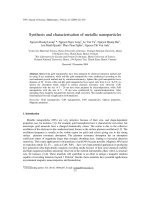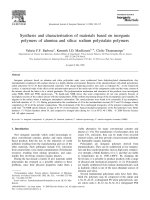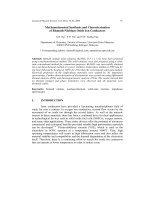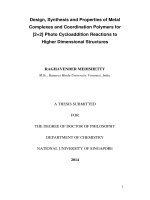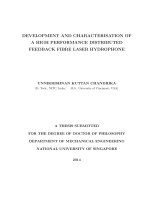Synthesis and characterisation of electrical conducting polymers co polymers based on omega functionalised 3 alkylthiophenes 2
Bạn đang xem bản rút gọn của tài liệu. Xem và tải ngay bản đầy đủ của tài liệu tại đây (407.19 KB, 47 trang )
Chapter 2
Syntheses and Characterisation of Electrically
Conductive and Fluorescent Poly[3-( -
bromoalkyl)thiophenes]
32
1.
Introduction
1.1
Conducting
p
olythiophene
Amongst the many families of electrically conductive materials, functionalised
polythioph
enes have always occupied an important position. Apart from their
good electrical properties, processibility, environmental stability and amenity to
wide
-ranging potential technological applications, their optical properties
[1],
thermochromistic
[2], piez
ochromistic
[3], luminescence [4] behavior are all
attracting increasing research interests. Chemical modification of monomeric
building blocks in these conducting polymers allows for the structural control and
tailoring of the respective polymer properties. In particular, pendant
functionalisation offers an attractive possibility of developing materials that, in
addition to particular polymer electronic properties, incorporate specific
properties of the pendant functionality [5]. It was also reported that
the
semiconducting conjugated polymers exhibit fluorescent characteristics, which
made them potential materials for application as polymer light-emitting diodes
(PLEDs)
[6].
33
1.2
Functionalised poly(3
-alkylthiophene)
A variety of chemically modified structures have been developed through
substitution on the thiophene ring [7]. Attachment of pendant alkyl chains of
suitable lengths at the 3
-
position of thiophene has been shown to afford a series of
solvent processible and fusible poly(3-alkylthiophenes) [8]. Amongst the many
poly(3
-alkylthiophenes) formed, poly[3-( -substituted alkyl)thiophene] is of
particular interest. It is anticipated that the functionalisation of the alkyl pendant
chain with reactive -moieties in polythiophenes will produce novel kinds of
practically useful polymers. These polymers would lend themselves to post-
polymerisation treatment processes, particularly in the generation of electrically
conductive composite materials for anti
-
static applications. Previous efforts in this
direction
include poly[3-( -hydroxyalkyl)thiophene] of different chain lengths
[9], which demonstrated comparable conductivity to those of poly(3-
alkylthiophene) upon doping but reduced solubility due to the hydroxyl moieties.
It has also been proven that the hydroxyl group is still an active functional group
after polymerisation [10]. This
creates
the possibility of post-
polymerisation
treatment to generate new material. As the first step of developing new material
that graft commodity polymer and conductive polymer, this chapter report the
findings on the preparation and properties of functionalised polythiophene with
-bromoalkyl substituents [
viz
. Poly(Th-C
n
-Br) n=4, 6, 8, 10, 12]. These
polymers are anticipated to be amenable to facile synthetic transformation to a
range of other functional materials via the reactive halide moiety.
34
The syntheses of the monomeric 3-( -bromoalkyl)thiophenes have been reported
briefly by Bäuerle
et al.
[11]. In this work, a straightforward FeCl
3
polymerisation
approach was utilised in order for preliminary data on the polymer properties to
be evaluated. These functionalised polymers themselves may also be applicable in
the field of sensors, microelectronic devices and/or electro
-
catalysis
[12].
35
1.3
Scope of the work in this chapter
1)
To synthesise the following monomers:
3-( -
bromobutyl) thiophene (THC
4
Br)
3-( -
bromohexyl) thiophene (THC
6
Br)
3-( -
bromooctyl) thiophene (THC
8
Br)
3-( -
bromodecyl) thiophene (THC
10
Br)
3-( -
bromododecyl) thiophene (THC
12
Br)
2)
To characterise all monomers synthesised by structural techniques
using
analytical instruments such as Fourier Transform infrared spectroscopy (FT-
IR
),
nuclear magnetic resonance spectroscopy (NMR), mass spectrometry (MS) and
elemental analysis.
3)
To effect chemical polymerisation of the monomers synthesised by FeCl
3
oxidative method to form the following polymers:
4)
To characterise all polymers formed by structural techniques
using
analytical instruments such as Fourier Transform infrared spectroscopy (FT-
IR
),
nuclear magnetic resonance spectroscopy (NMR), gel permeation
chromatography (GPC) and elemental analysis.
5)
To study the conductivity of the polymers and the effects of dopants on
conductivity.
S
(
C
H
2
)
n
B
r
[
]
m
n = 4 pTHC
4
Br
6 pTHC
6
Br
8 pTHC
8
Br
10 pTHC
10
Br
12 pTHC
12
Br
36
6)
To study the electro-optical properties of the polymers through ultraviolet
absorption
spectrometry (UV) and fluorescence emission spectrometry.
7)
To determine the thermal properties of the polymers by thermogravimetry.
8)
To analyse the surface characteristics of the polymers by X-
ray
photoelectron spectroscopy (XPS).
9)
To test the possibility of effecting functional group transformation via the
reactive
-
bromo moiety
.
37
2.
Experiment
2.1
Synthes
es of monomers
2.1.1
Overview
Monomers were synthesised in accordance to the method of Bäuerle et al.
[11],
which is depicted in Scheme 2.1.
Scheme 2.1
Monom
er synthesis. Reagents and conditions: (i) KOH/MeOH,
acetone, reflux; (ii) Mg, I
2
, anhydrous ether, reflux; (iii)
Ni(dppp)Cl
2
, anhydrous Ether; (iv) HBr/Ac
2
O, 100
C
The
-
(p
-methoxyphenoxy)alkyl bromides, easily prepared from , -
dihaloalkanes and hydroquinone monomethyl ether (HCM), react readily with
magnesium to give the corresponding Grignard compounds. The -(p-
methoxyphenoxy)alkyl bromides (n = 4, 6, 8, 10, 12) undergo nearly quantitative
Grignard reaction to afford its alkylmagnesium bromides Grignard reagent (n = 4,
6, 8, 10, 12). The nickel-catalysed Grignard coupling of 3-bromothiophene and
BrMg(CH
2
)
n
O
OCH
3
S
Br
+
S
(CH
2
)
n
O
OCH
3
S
(CH
2
)
n
Br
n = 4, 6, 8, 10, 12
i
ii
Br(CH
2
)
n
Br
+
OCH
3
HO OCH
3
Br(CH
2
)
n
O
iii
iv
(I)
(II) (III)
(IV)
(V)
38
the alkyl magnesium bromides (n = 4, 6, 8, 10, 12) (0.1
–
1 mol % Ni(dppp)Cl
2
as
catalyst in refluxing ether or THF*) leads to the terminally protected 3-[ -(p-
methoxyphenoxy)alkyl] thiophenes, which after a single recrystallisation, can be
obtained in 63
– 81% yield as a colourless, analytically pure solid.
Of the numerous ether cleavage methods, that with hydrogen halide/acetic
anhydride proved to be best suited for the cleavage of the HCM protecting group
in 3-[ -(p-methoxyphenoxy)alkyl] thiophenes. These 3-substituted thiophenes
were thus converted directly into 3-( -bromoalkyl)thiophenes. The best yields
were obtained using HBr/Ac
2
O at 100
C/20
-
25
hr
for 3-( -
bromoalkyl)
thiophenes. After separation of the simultaneously formed hydroquinone followed
by chromatographic and distillative purification, halides were obtained as
analytically pure compounds in 51
–
76% yield.
In an attempt to achieve a higher yie
ld
for
the key monomer, the p-
methoxyphenoxy protecting groups were replaced with p-methylphenoxy and p-
t
butylphenoxy protecting groups
for
, -dibromodecane. The same procedure
was followed except HCM was replaced with p-methylphenol and p-
t
butylphenol
re
spectively in the first step. The yields were compared.
* For n = 8, 10, 12, THF was used due to the decreasing solubility of the alky
magnesium
Grignard
reagent in ether which cause
d
practical difficulties in the transferring process.
39
2.2
Polymerisation
The following polymers were formed:
S
(
C
H
2
)
n
B
r
[
]
m
n = 4 pTHC
4
Br
6 pTHC
6
Br
8 pTHC
8
Br
10 pTHC
10
Br
12 pTHC
12
Br
Polymerisation was carried out using the method of Casa et al.
[13].
Poly[3
-( -
bromoalkyl)thiophenes] were obtained by dropwise addition of FeCl
3
in
nitromethane to a solution of the monomer in carbon tetrachloride. Since FeCl
3
is
insoluble in CCl
4
, FeCl
3
(the active state of the oxidant) gradually precipitates and
reacts with the monomer. This is a uniformed polymerisation method with the
formation of a very fine powder suspension of the polymers. The as-
synthesised
polymers, i.e. complexed (doped) with FeCl
3
, could be completely changed to the
neutral (undoped) state by soxhlet extraction with methanol and acetone in turn.
The dedoping was evidenced from the disappearance of characteristic doping
bands in the
FT
-
IR
sp
ectrum, at 1150 cm
-1
and 1350
cm
-1
.
As a comparison, the method of Sugimoto et al.
[14]
,
the usual method for
oxidative polymerisation using a suspension of FeCl
3
in dry chloroform was also
used for 3-( -
bromohexyl)thiophene.
This was effected by either rapid addition
of the monomer solution in one portion (PBHT2) or adding the monomer solution
dropwise generated the polymers (PBHT3).
40
3.
Results and Discussion
3.1
Experiments on different protecting group
According to the method of Bäuerle et al. (scheme 2.1), the p-
methoxyphenoxy
group was used as a protecting group and was later cleaved using hydrogen
halide/acetic anhydride to afford the monomer. One of the by-products of the
cleavage reaction was found to be 3-[ -(p-phenoxy)alkyl] thiophenes, which
indica
ted that cleavage could also occur on the methoxy group. In the hope of
eliminating this side reaction, p-methylphenoxy and p-
t
butylphenoxy protecting
groups were tested. It was found that the yields of
the
monomer
s w
ere
32% and
20% respectively for these two protecting groups. The lower yield indicated that
the presence of the methoxy group did help the cleavage of the protecting group
in the original reaction. The electron donating effect of the methoxy group makes
the protecting group electron rich, hence function as a better leaving group under
acidic conditions. Replacing this methoxy group with methyl or p-
t
butylphenoxy
group could not compensate for this electron donating effect thus the yield was
lower, even though the side reaction was eliminated.
41
3.2
Structural
c
haracterization of
s
ynthesised
m
onomers
All 3-( -bromoalkyl)thiophenes and their predecessors were characterised by
NMR. The monomers were also characterised by MS, FT-
IR
and elemental
analys
i
s.
In the NMR spectra of all monomers, multiplets at around
7.2
ppm indicated
aromatic Hs on position 4 of
the
thiophene ring. Multiplets at around
6.9
ppm
indicated aromatic Hs on positions 2 & 5 of the thiophene ring. The presence of
the Br functional group was confirmed by the triplet at around
3.4
ppm, which
showed methylene protons being deshielded by the adjacent bromine group.
The
NMR analyses results is in good accordance with the literature reported value
[11].
An overlaid IR spectrum of all monomers is shown in Figure 2.1.
Bands at around 3110
cm
-1
and 3050
cm
-1
were results of C-H stretching for H
(Hs at positions 2 and 5 on the thiophene ring) and H
(H on position 4 of the
thiophene ring). The longer the polythiophene chain the more
extensive
the
delocalisation
. As a result the bond order reduced and the intensities of these
peaks
were getting weaker. Band absorptions appearing at
1250
cm
-1
, 645 cm
-1
and 565 cm
-1
were attributed to the addition of
the bromo
group. Attention should
be drawn to C-H
stretching
(3110
cm
-1
)
and bending bands, since these should
42
change in
the
polymer IR spectrum and give structural information of the
polymers.
Fig. 2.1
Overlaid FT-IR spectra of all monomers. From top to bottom:
THC4Br, THC6Br, THC8Br, THC10Br, and THC12Br
43
3.3
Physical properties of pol
ymers
The neutral polymers synthesised using the approach by Casa et al. [13] in carbon
tetrachloride
solvent were all black powders which were largely soluble in
moderately polar organic solvents such as chloroform, tetrahydrofuran and
benzene. In addition, for the polymer series with n-( -bromohexyl) pendant, the
polymers obtained through the method of Casa et al. [13] were found to be more
soluble than the polymers yielded through the Sugimoto approach [14]. Further,
of the two polymers formed using the Sugimoto approach, the polymer (
na
med
PBHT3)
synthesised by the dropwise addition of the monomer was found to have
higher solubility compared to the polymer formed by adding the monomer in one
portion (
named
PBHT2). The solubilised polymers were extracted using soxhlet
extraction in CHCl
3
and adopted for subsequent UV-Vis, fluorescence, NMR and
GPC characterisation studies.
The bulk stoichiometry of the polymers was determined from elemental
microanalys
is results. Upon normalisation of the sulphur contents, the empirical
formulae of the polymers displayed good agreement between the expected and
calculated carbon and hydrogen values, although the bromine content was found
to be lower. A possible rationale for this may be functional group degradation or
substitution during polymerisation on account of the presence of a high
concentration of HCl in the solution [15, 16].
44
Table 2.1 summarises the number average molecular weight (M
n
) for the neutral
polymers as determined from GPC. The data was compared to poly(3-
hexyl)thiophene (PHT) that was obtained using the method of Casa et al. [13].
These polymers with n-( -bromoalkyl) pendants have a polydispersity index
(PDI) ranging from
ca
1.7 to 2.0. The M
n
of the polymers ranged from 12,300 to
29,400, which corresponds to a degree of polymerisation (DP) comprising 57-
93
monomeric units. While pTHC4Br, pTHC6Br and pTHC8Br were totally soluble
in THF, pTHC10Br and pTHC12Br were only partially soluble. Thus the
molecular weights obtained from the soluble portion of the bulk of these two
polymers possibly represent only the lower molecular weight fractions, the
insoluble fractions
we
re expected to possess higher molecular weights. When the
polymers generated under different conditions were compared, a relatively higher
DP was achieved by using the Sugimoto approach, which invariably resulted in
polymers with lower solubility.
Table
2.1
Summarised data of polymers formed
Polymer
GPC results
Conductivity
HT dyads
HH dyads
DPn
Mn
PDI
I
2
doped
(Scm
-1
)
% %
pTHC4Br
57
12,3
00
1.8
4.7
68
32
pTHC6Br
82
19,9
00
2.0
7.9
73
27
pTHC8Br
93
25,200
1.8
10.4
87
13
pTHC10Br
73
22,000
2.0
8.4
62
38
pTHC12Br
90
29,400
1.7
7.5
60
40
PHT
138
23,
100
2.7
9.3
71
29
PBHT2
95
23,4
00
1.9
8.2
70
30
PBHT3
92
22,6
00
2.0
7.9
68
32
DPn is the average degree of polymeri
s
ation
.
45
3.
4
FT
-
IR
and
1
H NMR characterisation
Figure 2.2 depicts the FT-IR spectra of
pTHC4Br
,
pTHC6Br
,
pTHC10Br
,
pTHC6Br
after I
2
doping and 3-( -
bromohexyl)thiophene.
In the spectra of
neutral polymers, for example in the spectrum of pTHC6Br, the presence of t
he
bromide moiety afforded absorption bands at 1254 (-
CH
2
- deformation), 645 and
556 cm
-1
(C
-Br stretching) [17].
In addition, the polymers depicted bands at 3052 cm
-1
which are ascribable to
thienylene C-H
stretching and 829 cm
-
1
due to C-H
bending of a 2,3,5-
trisubstituted thienylene moiety [18]. Although the thienylene C-H
stretching
and bending modes at 3114 and 768 cm
-1
respectively are clearly evident in the
monomers, these bands are very much attenuated in the polymer. This indicates
that there
is a predominant
- coupling of thiophenes upon polymerisation.
Other characteristic bands in the polymers include the alkyl-
CH
2
asymmetric and
symmetric stretching at 2929 and 2856 cm
-1
, as of aromatic ring-vibrations at
1466 cm
-1
. Upon doping with I
2
, the polymers, as exemplified in pTHC6Br, took
on a noticeable change in their IR spectra. Thus, strong and broad doping
-
induced
bands at 500 - 1500 cm
-1
became evident, which are due to the presence of free
charge carriers typical in organic semiconductor
s [19].
46
Fig.
2.2
FT-IR spectra of polymers before and after soxhlet extraction
(doped and undoped) From top to bottom: (a) undoped pTHC4Br;
(b) pTHC6Br; (c) pTHC10Br; (d) doped pTHC6Br and (e) 3-( -
bromohexyl)thiophene
47
A representative solution
1
H NMR
spectrum of these materials is shown in Figure
2.3 for the polymer pTHC6Br. The band at
ca
3.4 ppm is assigned to methylene -
CH
2
-Br proton resonance whilst that at
ca
2.8 and 2.5 ppm are ascribed to the
methylene protons on the pendant chain immediately adjacent to the thienylene
rings which are arranged respectively in a head-
to
-tail (HT) and head-
to
-
head
(HH) dyad configuration [20]. From the ratio of the integration of these signals,
the relative proportions of HT
: HH dyads in the polymer can be determined to be
approximately 2.72: 1 corresponding to a 73 / 27 ratio of the respective dyads in
pTHC6Br. Proton resonance in the range
6.8-7.2 ppm is typical of hydrogen on
polymer thienylene rings. The four sets of singlets in the aromatic region can be
attributed to the contribution in the polymer of the triads HT
-
HT (
6.98), HT
-
HH
(
7.00), TT
-
HT (
7.02) and TT
-
HH (
7.05) linked thiophene rings [21].
The
1
H NMR spectra of the other four polymers were assigned in a similar way to
that of pTHC6Br. In these, the estimated ratios of HT to HH dyads are 68/32 and
62/38 respectively for pTHC4Br and pTHC10Br (Table 2.1). Although increasing
proportions of HT dyads are expected with increase in pendant alkyl chain lengths
[31], the obtained experimental results proved otherwise. This inconsistency may
have arisen from the steric effects exerted by the bulky bromine group. From
Table 2.1, it is also evident that poly[3-( -bromohexyl)thiophene] prepared by
the method of Casa et. al has a similar degree of regioregularity compared to that
of the Sugimoto approach [14].
48
Fig. 2.3
NMR spectrum of pTHC6Br
49
3.5
Electrical conductivity of the doped polymers
The maximum conductivity of the polymers upon doping with I
2
is shown in
Table 2.1. Here, the maximum conduct
ivity was attained with an I
2
weight
-
uptake
of
ca
100 % w/w. The other two polymers with different chain lengths displayed
similar conductivity trends. The conductivity of I
2
-doped polymers PHT, PBHT2
and PBHT3, were also examined for comparative purposes. In these
investigations, it was found that the maximum conductivity for the series of
poly[3
-( -bromoalkyl)thiophene]s and PHT are all within the same order of
magnitude.
The maximum conductivity of I
2
-
doped pTHC6Br was obtained only after several
repea
ted attempts on account of the brittle nature of the polymer upon doping. It
can be seen that the conductivity of the -bromine substituted polymers were
only slightly lower than that of the PHT polymer. This suggests that the presence
of the -bromo moiety has only marginal effects on the polymers’ macroscopic
conductivity.
Also, the varying alkyl chain length did not affect the polymers’
conductivity drastically. The result is in contrast to earlier observations by
Kaeriyama
et al. [22]. In their study of polyalkylthiophenes where it was found
that the introduction of longer n-alkyl chains decreases the resulting conductivity
in the doped state. Furthermore, with our polymers, different polymerisation
conditions appear to have only a slight influence on el
ectrical conductivity.
50
3.6
UV
-
Vis and fluorescence spectroscopy
Standard polymer solutions of 10
-5
M in chloroform were used for studies in UV-
Vis absorption and fluorescence spectroscopy. Dilute solutions were used in order
to avoid the possibility of concentration quenching or re-absorption / re-
emission
with all solutions being degassed prior to the measurements. The condensed-
phase UV-Vis absorption spectra of polymers were obtained from thin films on
ITO glass prepared by spin-casting from chloroform solutions of
ca
10
-3
M.
Fluorescent quantum yields (
s
) were evaluated by comparison with quinine
sulfate solutions [32] in 0.1 M H
2
SO
4
using the following equation [23]:
r
s
s
r
rs
I
I
A
A
where
A
s
and A
r
are the absorbances of the sample and reference solutions, I
r
and
I
s
are the corresponding relative integrated fluorescent intensities. Table 2.2
summarises the electronic absorption, emission maxima and the quantum yields
relative to quinine sulphate (Spectra not shown here). Measurements on PHT
were also conducted under identical conditions for comparative purposes.
Table2.2
Optical properties of the polymer
Polymer
UV
-
Vis
max
(nm)
Fluorescence
max
a
(nm)
Quantum
yield
c
Solution
a
Film
b
Emission
(%)
pTHC4Br
428
485
550
8.8
pTHC6Br
434
488
558
11.1
pTHC8Br
435
-
555
10.0
pTHC10Br
432
484
554
8.4
pTHC12Br
439
-
555
9.0
PHT
434
497
560
9.0
a : 10
-
5
M in CHCl
3
b : cast from 10
-3
M CHCl
3
solution
c : relative to 10
-5
M quinine sulfate in 0.1 M H
2
SO
4
51
All polymers showed similar characteristics with two absorption maxima: a less
intense band at
ca
260 nm attributable to localized - * transitions of the
thienylene rings and a second maxima at higher wavelength ascribable to the
-
*
transition of the -conjugated system of the polymer backbone [24]. Whilst the
first absorption maxima (
max
) was found to be less dependent on the extent of
conjugation, the position of the latter band is bathochromatically shifted with
increasing effective conjugation alon
g the polymer chain.
However, the differences in
max
of these polymers are rather small as
summarised in Table 2.2, This is most likely due to the presence of the bulky -
bromo moiety, which should enhance the rigidity of the backbone structure. The
eff
ect should be more important to polymers with a shorter chain pendant group,
since those with a bulky longer chain pendant group already have a rigid
backbone structure. Therefore the
max
of these polymers are not very far apart.
Further, when their
max
are compared to that of PHT, we can see that the -
bromo moiety only have a marginal effect on the polymers’ electro-
optical
property. This is also in agreement with the observation of their macroscopic
conductivity.
When polymers pTHC4Br, pTHC6Br and pTHC10Br were cast from chloroform
solutions of
ca
10
-
3
M to afford thin films on ITO glass, a red shift in the
max
of
ca.
52 - 61 nm with respect to the polymer solution was observed in the UV-
Vis
spectra (Table 2.2). This effect is ascribed to conformational changes that induce
52
a higher degree of planarity and hence a higher degree of conjugation in the
polymers’ condensed phase [25]
.
Table 2.2 also summarises the electronic emission maxima and the solution
quantum yields with respect to quinine sulphate. The polymers’ fluorescence
quantum yields, as calculated by the approach of Davey et al. [26], ranged from
8.4 to 11.1 % with pTHC6Br having a higher value compared to PHT measured
under identical conditions. However, the differences in quantum yields of
these
three polymers are small relative to quinine sulphate. Once again this could be
attributed to the effect of the bulky -bromo moiety enhancing the rigidity of the
polymer backbone structure. As was discussed in the previous section, the effect
is more pronounced for the polymers with shorter pendant chains. Since quantum
yield is related to the rigidity of the polymer backbone structure, the similar
rigidity of this series of polymers resulted in their having similar quantum yields.
53
3.7
Thermal stabi
lity of the neutral polymers
The thermal properties of the poly[3
-( -
bromoalkyl)thiophenes], with different n
-
alkyl pendants in their neutral and doped states were investigated. Degradation of
neutral polymers occurred through three distinct weight
-
loss st
eps in air.
Fig.2.4 illustrates the % weight loss versus temperature of neutral pTHC6Br in
air. Here, thermal oxidative degradation of pTHC6Br occurs over a temperature
range from 180 to 700
o
C, with three maximum rates of degradation at 330, 455
and 580
o
C, leaving residues of less than 2% upon complete degradation. This
three
-step degradation involved the sequential elimination of the bromine moiety,
cleavage of the n-alkyl pendant group and backbone decomposition of the
polymer. The change in weight percentages of this three-step degradation
correlates well with the above decomposition modes.
In N
2
, thermal degradation started at 180
o
C with maximum rates of degradation
occurring at 320 and 480
o
C. These first two steps are similar to the degradation
patt
ern of pTHC6Br in air. However, unlike in air, the degradation rate of the
polymer was much slower in N
2
at temperatures above 600
o
C. When the
temperature reached 1000
o
C about 16% of the residue remained.
54
Fig. 2.4
TGA curve of pTHC6Br in air
Neutral pTHC6Br is less stable compared to PHT, which was obtained using the
same polymerisation approach. The other four polymers showed similar
degradation characteristics both in air and in nitrogen. In comparison to PHT and
other polyalkylthiophenes reported [27] which are stable beyond 200
o
C, the
current series of poly[3-( -bromoalkyl)thiophene]s have lower thermal stability
on account of the facile elimination of reactive
-
bromine.
The I
2
-doped polymers depict similar thermal decomposition patterns compared
to the neutral polymers discussed above. For degradation of I
2
-
doped pTHC6Br in
air, the first step, ascribable to loss of molecular iodine, has an onset temperature
of 30-
40
o
C. The second weight-loss step started at about 200
o
C whilst the
55
maximum decomposition rates occurred at 120, 300 and 465
o
C. Over the 200
to
365
o
C ranges, changes in the weight percentages of doped pTHC6Br, correlated
well with the degradation of bromine and the alkyl pendant.
